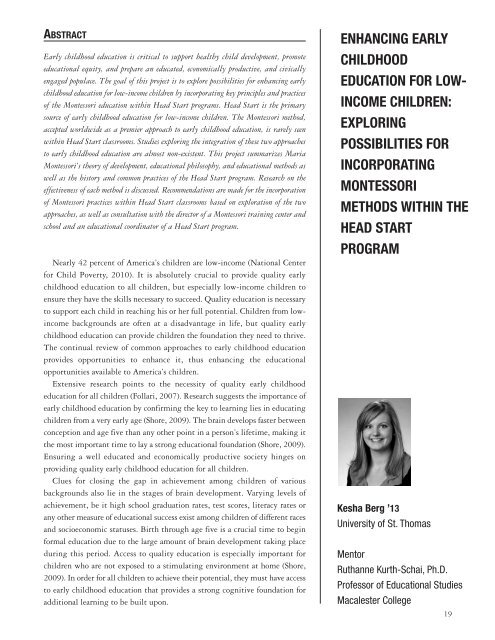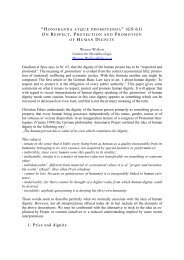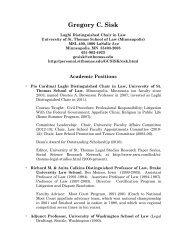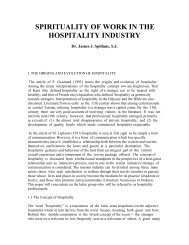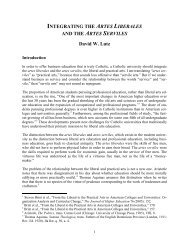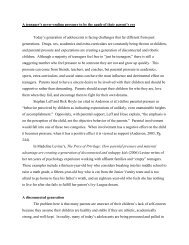dr. ronald e. mcnair acknowledgements - University of St. Thomas
dr. ronald e. mcnair acknowledgements - University of St. Thomas
dr. ronald e. mcnair acknowledgements - University of St. Thomas
You also want an ePaper? Increase the reach of your titles
YUMPU automatically turns print PDFs into web optimized ePapers that Google loves.
ABSTRACT<br />
Early childhood education is critical to support healthy child development, promote<br />
educational equity, and prepare an educated, economically productive, and civically<br />
engaged populace. The goal <strong>of</strong> this project is to explore possibilities for enhancing early<br />
childhood education for low-income chil<strong>dr</strong>en by incorporating key principles and practices<br />
<strong>of</strong> the Montessori education within Head <strong>St</strong>art programs. Head <strong>St</strong>art is the primary<br />
source <strong>of</strong> early childhood education for low-income chil<strong>dr</strong>en. The Montessori method,<br />
accepted worldwide as a premier approach to early childhood education, is rarely seen<br />
within Head <strong>St</strong>art classrooms. <strong>St</strong>udies exploring the integration <strong>of</strong> these two approaches<br />
to early childhood education are almost non-existent. This project summarizes Maria<br />
Montessori’s theory <strong>of</strong> development, educational philosophy, and educational methods as<br />
well as the history and common practices <strong>of</strong> the Head <strong>St</strong>art program. Research on the<br />
effectiveness <strong>of</strong> each method is discussed. Recommendations are made for the incorporation<br />
<strong>of</strong> Montessori practices within Head <strong>St</strong>art classrooms based on exploration <strong>of</strong> the two<br />
approaches, as well as consultation with the director <strong>of</strong> a Montessori training center and<br />
school and an educational coordinator <strong>of</strong> a Head <strong>St</strong>art program.<br />
Nearly 42 percent <strong>of</strong> America’s chil<strong>dr</strong>en are low-income (National Center<br />
for Child Poverty, 2010). It is absolutely crucial to provide quality early<br />
childhood education to all chil<strong>dr</strong>en, but especially low-income chil<strong>dr</strong>en to<br />
ensure they have the skills necessary to succeed. Quality education is necessary<br />
to support each child in reaching his or her full potential. Chil<strong>dr</strong>en from lowincome<br />
backgrounds are <strong>of</strong>ten at a disadvantage in life, but quality early<br />
childhood education can provide chil<strong>dr</strong>en the foundation they need to thrive.<br />
The continual review <strong>of</strong> common approaches to early childhood education<br />
provides opportunities to enhance it, thus enhancing the educational<br />
opportunities available to America’s chil<strong>dr</strong>en.<br />
Extensive research points to the necessity <strong>of</strong> quality early childhood<br />
education for all chil<strong>dr</strong>en (Follari, 2007). Research suggests the importance <strong>of</strong><br />
early childhood education by confirming the key to learning lies in educating<br />
chil<strong>dr</strong>en from a very early age (Shore, 2009). The brain develops faster between<br />
conception and age five than any other point in a person’s lifetime, making it<br />
the most important time to lay a strong educational foundation (Shore, 2009).<br />
Ensuring a well educated and economically productive society hinges on<br />
providing quality early childhood education for all chil<strong>dr</strong>en.<br />
Clues for closing the gap in achievement among chil<strong>dr</strong>en <strong>of</strong> various<br />
backgrounds also lie in the stages <strong>of</strong> brain development. Varying levels <strong>of</strong><br />
achievement, be it high school graduation rates, test scores, literacy rates or<br />
any other measure <strong>of</strong> educational success exist among chil<strong>dr</strong>en <strong>of</strong> different races<br />
and socioeconomic statuses. Birth through age five is a crucial time to begin<br />
formal education due to the large amount <strong>of</strong> brain development taking place<br />
during this period. Access to quality education is especially important for<br />
chil<strong>dr</strong>en who are not exposed to a stimulating environment at home (Shore,<br />
2009). In order for all chil<strong>dr</strong>en to achieve their potential, they must have access<br />
to early childhood education that provides a strong cognitive foundation for<br />
additional learning to be built upon.<br />
ENHANCING EARLY<br />
CHILDHOOD<br />
EDUCATION FOR LOW-<br />
INCOME CHILDREN:<br />
EXPLORING<br />
POSSIBILITIES FOR<br />
INCORPORATING<br />
MONTESSORI<br />
METHODS WITHIN THE<br />
HEAD START<br />
PROGRAM<br />
Kesha Berg ’13<br />
<strong>University</strong> <strong>of</strong> <strong>St</strong>. <strong>Thomas</strong><br />
Mentor<br />
Ruthanne Kurth-Schai, Ph.D.<br />
Pr<strong>of</strong>essor <strong>of</strong> Educational <strong>St</strong>udies<br />
Macalester College<br />
19


